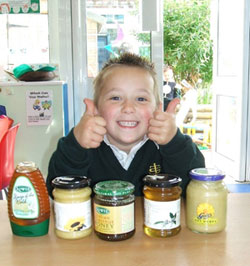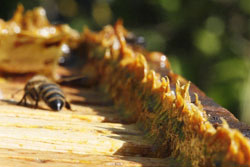Ever since man has been keeping honey bees, the use of hive products in medicine has been important, especially the use of honey in wound healing. In recent years, searches for “alternative medicine” has led to a resurgence in interest. Unfortunately, along with evidence based research, wild unsubstantiated claims for health benefits have often also been made. It is thus important to sift through reports for genuine effects rather than speculation. The Journal of ApiProduct and ApiMedical Science publishes objective scientific studies on the effects of hive products. Bee products may trigger allergies in sensitive individuals and care needs to be taken in their use.
Honey
 Honey is a popular bee product and is enjoyed by many.
Honey is a popular bee product and is enjoyed by many.
Honey has been used for wound healing since biblical times. The widespread use of cheap antibiotics led to a decline in the use of honey, but the rise of antibiotic resistant pathogens such as MRSA has led to increasing use. Honey has several modes of action. Firstly as a super saturated sugar solution it has an osmotic effect, secondly, it produces hydrogen peroxide, which has known antimicrobial effects. Thirdly, there are non-peroxide effects, such as the “Unique Manuka Factor” found in Manuka honey. The mode of action of such factors are not well understood, and much research is in progress.
Pollen
There is much anecdotal evidence that the consumption of local pollen has a beneficial effect on hayfever sufferers. Definite medical evidence is lacking, and more research is needed.
Beeswax
Beeswax has long been used as a basis of many cosmetics and pharmacological preparations, mainly because it is stable and inert. It thus has few pharmacological properties of its own.
Propolis
 Propolis is a resinous mixture that honey bees collect from tree buds, sap flows, or other botanical sources.
Propolis is a resinous mixture that honey bees collect from tree buds, sap flows, or other botanical sources.
Propolis, which consists of a range of plant resins collected by the bees and used to seal holes in the hive, has been used for a variety of purposes. It is now known to have a diverse range of pharmacological properties, including anti-inflammatory, anti-oxidant, anti-bacterial, anti-fungal, anti tumour and some anti-viral properties. Its composition, is, however, extremely variable, which has made standardisation difficult, and hindered its medicinal use. Much more research is needed.
Royal jelly
Royal jelly is the protein rich secretion of nurse bees which is fed to all honey bee larvae for the first few days, and those destined to become queens throughout their development. It induces significant developmental changes in these queens. Royal Jelly is widely used as a food supplement, and whilst there is some evidence that Royal Jelly may have some cholesterol-lowering, anti-inflammatory, wound-healing, and antibiotic effects, these are unlikely to be achieved through oral ingestion. Much more research is needed.
Bee venom
Bee venom consists of many components, the most important being the protein mellitin, which has a powerful anti-inflammatory action. Bee venom therapy is claimed to have effects on arthritis, bursitis, tendinitis and multiple sclerosis, but there have been few controlled studies. There is little standardisation of the method of application, and a serious risk of allergic reaction. Much more research is needed.


